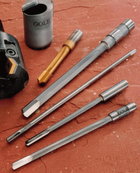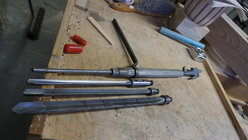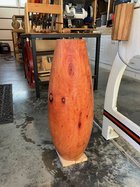I'm looking for ideas on boring deep (up to 25") pilot holes for hollowing large vases and keeping them on or close to center. It's very hard to keep the pilot hole on center once you get out past 15 inches or so. If you've ever hollowed something very deep with a pilot hole opening that is off center you know how challenging it can be. You're already extended far off your tool rest and if your opening is way off center it can be brutal to try and get it back centered to finish hollowing. Plus, getting the bottom and bottom curve transition consistent is key to minimizing cracking.
I currently use Milwaukee switchblade bits for doing my pilot holes. The largest I use is 2 9/16". I drill a 1/2" center hole to about 5", then switch to the Milwaukee bit, then drill another 1/2" hole, then switch again, etc. Things usually go well for the first 15 inches or so. The Milwaukee bits have a self feed tip that fits well into a 1/2" pilot hole. I repeat this step process all the way to the bottom. Once you get long extensions on your bits a slight wobble can easily begin to become a spiral, especially if the pith and wood grain begin to lead the bit astray. I drill on my lathe with a Jacobs chuck and #2MT.
I currently use Milwaukee switchblade bits for doing my pilot holes. The largest I use is 2 9/16". I drill a 1/2" center hole to about 5", then switch to the Milwaukee bit, then drill another 1/2" hole, then switch again, etc. Things usually go well for the first 15 inches or so. The Milwaukee bits have a self feed tip that fits well into a 1/2" pilot hole. I repeat this step process all the way to the bottom. Once you get long extensions on your bits a slight wobble can easily begin to become a spiral, especially if the pith and wood grain begin to lead the bit astray. I drill on my lathe with a Jacobs chuck and #2MT.




